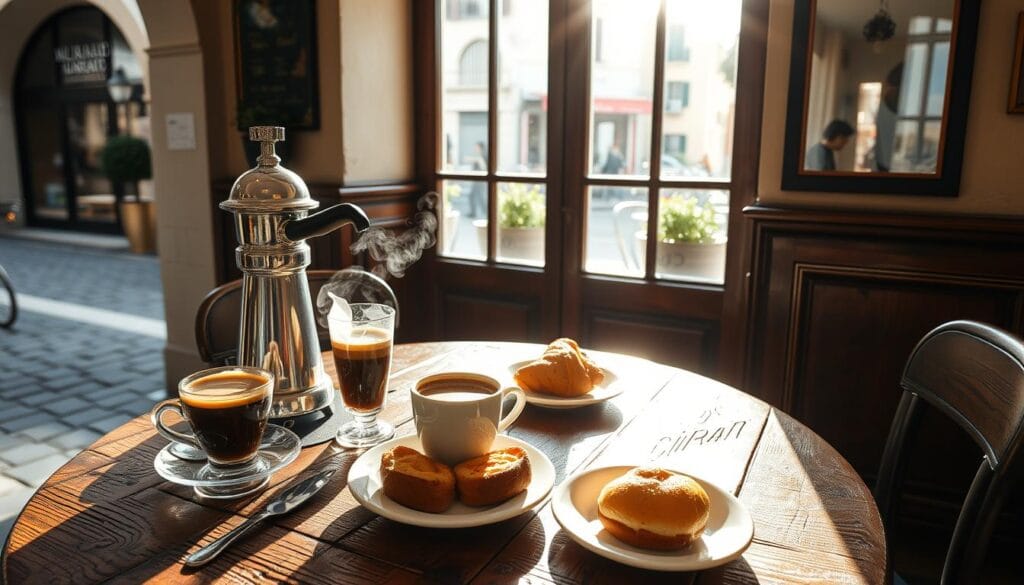As the sun rises, Italy’s streets come alive with a special breakfast ritual. It’s a time of peace and pleasure, a sweet start to the day. Enjoying a creamy cappuccino or a flaky cornetto filled with Nutella, the Italian breakfast awakens your senses and feeds your soul.
In Italy, breakfast gives you about 20% of your daily energy. It’s a mix of carbs, proteins, vitamins, sugars, and fats, all in delicious flavors. From the Alps to the southern coasts, each region’s breakfast shows Italy’s rich food culture. Yet, they all share a common thread, weaving a unique tapestry of tastes, smells, and traditions.
Enjoying a cornetto with espresso, creamy yogurt with fruit, or homemade bread with jam, the Italian breakfast is pure joy. It’s a time to appreciate the simple things, share moments with family, and start the day feeling calm and happy.
An Introduction to Italian Breakfast Culture
Breakfast in Italy is special and loved. It’s different from the big, savory meals in the United States. Italian breakfasts are light, sweet, and focus on quality, not how much you eat.
This morning meal is a way to start the day with energy and joy. It’s about enjoying the taste of food.
The Role of Breakfast in Italy
In Italy, breakfast is more than just a meal. It’s a key part of the day. People often have their breakfast at a café bar.
They sip on strong, tasty caffe (coffee) and enjoy a flaky cornetto (Italian croissant) or crunchy biscotti (cookies). This quick breakfast helps prepare for the day, giving energy and happiness.
Differences Between Italian and American Breakfasts
- Italian breakfasts are lighter, with pastries, breads, and fruit. American breakfasts are often bigger and savory.
- Coffee is central to Italian breakfasts. Drinks like cappuccinos and caffe lattes are enjoyed in the morning.
- Italians order and eat at the bar, making breakfast more social and lively. In America, people sit down at a table.
The Italian breakfast culture values quality, tradition, and enjoying food. It’s a unique and enjoyable way to start the day.
Common Breakfast Items in Italy
Exploring Italian breakfast is a joy. It combines traditional and modern tastes. This mix shows the true spirit of the typical Italian breakfast.
Coffee: The Heart of Italian Mornings
Coffee is key in Italian mornings. More than two-thirds of Italians begin with a strong coffee. They enjoy espresso, cappuccino, and latte macchiato. The smell of fresh coffee fills the air, making mornings special.
Pastries and Breads: A Sweet Start
Italians love sweet treats with their coffee. The cornetto, like a croissant, is a favorite. It’s often filled with custard, jam, or chocolate. They also enjoy fette biscottate, a rusk, with butter or jam.
Seasonal Fruit: Fresh and Flavorful
Fruits add a natural sweetness to Italian breakfasts. Winter brings juicy citruses, while summer offers ripe berries. These fruits add flavor and vitamins to start the day.
The Italian breakfast menu also includes yogurt, cereals, and biscotti. These are great for dipping in coffee.
“Breakfast in Italy is a simple yet delightful affair, where the perfect balance of coffee, pastries, and seasonal fruit sets the tone for the day ahead.”
Italian Coffee Rituals
Coffee is at the heart of the Italian breakfast. As soon as you enter an Italian café, you’re greeted by the rich aroma of coffee. The espresso, a strong coffee shot, is the favorite, often enjoyed quickly at the bar.
Espresso: The Quintessential Choice
Espresso is key to Italian coffee culture. Italians often start their day at a bar, where they enjoy a quick espresso. Though coffee quality varies, the espresso ritual is deeply valued.
Cappuccino: When and How to Drink It
The cappuccino is a beloved part of Italian breakfasts. It’s made with espresso, steamed milk, and foam. Italians usually drink cappuccinos before 11 am, as they’re seen as breakfast drinks. For those who find espresso too strong, the caffè macchiato is a good choice.
Italy also offers other coffee options. The latte is hot milk with foam, and the caffè d’Orzo is a decaf made with roasted barley. The caffè Shakerato, an espresso mixed with sugar syrup and ice, is perfect for summer.
There’s a certain etiquette to coffee in Italy, with certain drinks for specific times. Whether it’s a quick espresso or a cappuccino, diving into Italian coffee culture is a unique way to experience Italian breakfast.
Popular Italian Pastries
Italian breakfast pastries are a feast for the senses. From the famous cornetto to the beloved biscotti, these treats are key to Italy’s morning tradition.
Cornetto: The Italian Croissant
The cornetto, also known as the Italian croissant, is a breakfast favorite. It looks like a French croissant but tastes sweeter. You can find it filled with berries, apricot, cream, chocolate, or pistachio.
Biscotti: Perfect for Dipping
Biscotti, crunchy almond cookies from Prato, Tuscany, pair well with caffè. They’re great for dipping in espresso or cappuccino, offering a nice mix of textures and tastes.
But there’s more to Italian breakfast pastries than cornetto and biscotti. You should also try ciambella (Italian donut), maritozzo (sweet bread from Rome), and sfogliatelle (thin pastry with ricotta, from Naples).
The quality of these pastries can change a lot depending on where you are in Italy. Choosing a good pasticceria (pastry shop) is key to enjoying the real taste of Italian breakfast.
“In Italy, breakfast is not just a meal, it’s a ritual to be savored and enjoyed.”
Savory Options for Breakfast
While sweet pastries and breads are common in Italy, savory dishes also have a place. Especially in hotels for international guests. You can find everything from frittata to panini on Italian breakfast menus.
Frittata: An Italian Omelet
The frittata, an Italian-style omelet, is found in some regions. It’s made with eggs, veggies, cheese, and sometimes meat, baked until set. You can enjoy it warm or at room temperature, making it a great breakfast choice.
Panini: Toasted Sandwiches
In the north of Italy, panini (toasted sandwiches) are a breakfast favorite. They’re filled with cured meats, cheeses, and sometimes veggies, all pressed between crusty bread.
These savory dishes offer a tasty alternative to sweet breakfasts. Whether you choose a fluffy frittata or a crispy panini, Italian breakfasts are a delightful mix of flavors.
| Dish | Calories | Fat | Cholesterol | Sodium | Carbs | Protein |
|---|---|---|---|---|---|---|
| Italian Baked Eggs & Sausage | 408 | 27g | 241mg | 1183mg | 22g | 19g |
| Italian Sausage Egg Bake | 316 | 20g | 214mg | 546mg | 13g | 21g |
| Individual Frittatas | 339 | 24g | 456mg | 751mg | 6g | 24g |
| Italian Brunch Bake | 373 | 20g | 255mg | 839mg | 23g | 24g |
| Italian Garden Frittata | 183 | 11g | 228mg | 655mg | 4g | 18g |
“Breakfast is the most important meal of the day, and in Italy, it’s a time to savor the simple pleasures of good food and great company.”
Regional Variations of Breakfast
Breakfast in Italy is not the same everywhere. Each region has its own special morning meal. From the north’s hearty dishes to the south’s light treats, exploring these breakfasts is a tasty adventure.
Northern Italy: Heartier Mornings
In the north, breakfasts are bigger. In Genoa, you’ll find fugassa, a thick bread, with cappuccino. The Veneto region loves polenta for breakfast, giving you lots of energy.
Southern Italy: Lighter Choices
Going south, breakfasts are lighter and sweeter. In Rome, the maritozzo, a soft bun, is a favorite. Naples is famous for sfogliatelle, a flaky pastry. Sicily’s granita, a fruity or coffee dessert, pairs well with brioche.
Bread varies too. Rome has rosette, while the Alps have heartier breads.
“Exploring the diverse regional breakfast customs of Italy is a delightful way to immerse yourself in the country’s rich culinary heritage.”
Enjoying a cornetto in the north or granita in the south is a treat. These regional breakfasts show Italy’s rich food culture. Trying these local dishes makes your Italian breakfast better and helps you understand the country’s food diversity.
The Importance of Fresh Ingredients
Italian breakfasts rely heavily on fresh, quality ingredients. Many Italians love to shop at local markets for the best bread, fruits, and jams. They even use traditional Moka pots to brew coffee from freshly ground beans.
Local Markets: Where to Shop
Exploring a local Italian market is key to the breakfast experience. You’ll find a wide range of fresh Italian breakfast items, like bread and fruits. Italians prefer food from small producers and artisans over mass-made products.
Breakfast in Italian Families: Homemade Touches
Breakfast in Italian homes is a family event with homemade touches. You might enjoy fresh cakes, homemade jams, or whipped cream with your coffee. This shows the care and tradition in Italian cooking.
“The secret to a truly delicious Italian breakfast lies in the quality and freshness of the ingredients. Italians understand that simple pleasures, when made with care, can be the most rewarding.”
By focusing on fresh, local ingredients, Italians make their breakfasts a celebration of Italy’s food heritage. Every part of an Italian breakfast, from espresso to pastries, reflects Italy’s rich culinary traditions.
Breakfast Pairings to Enjoy
Italians are experts at pairing breakfast items for a perfect start. They love a cornetto (Italian croissant) with a cappuccino. Or, they enjoy biscotti with espresso. Each pairing is made to match the meal’s flavors and textures.
Ideal Beverages to Complement Your Meal
Coffee is key in Italian breakfasts. You can choose from espresso, cappuccino, or latte macchiato. These drinks go well with many breakfast items. For something lighter, try fresh fruit juice or granita (Italian ice).
Sweet vs. Savory Combinations
Italian breakfasts often favor sweet treats like cornetti and biscotti. But, they also enjoy savory options. A slice of focaccia with olive oil and sea salt is a great start, paired with a strong coffee.
For a healthier choice, try yogurt with fruit and honey. It’s a nutritious and tasty way to begin the day.
Choosing the right Italian breakfast combination is all about finding the perfect match. It’s about balancing your drink with your breakfast’s flavors.
When and Where to Have Breakfast in Italy
In Italy, breakfast is usually from 7:00 to 11:00 AM. Many people have a quick breakfast at home before work. Others like to start their day at a café with a standing espresso and pastry.
Weekends are different, with families enjoying a longer, more elaborate breakfast at home. The type of breakfast varies by region. Northern Italians often have a bigger breakfast, while southerners prefer lighter options.
Typical Breakfast Hours
Italians usually eat breakfast early, between 7:00 and 11:00 AM. They rarely have breakfast late, as they value an early start.
Cafés vs. Home Breakfast
- Breakfast at Italian cafés is quick, lasting about 15 minutes.
- Many prefer a simple breakfast at home, like a caffe latte or espresso with pastry or bread and jam.
- On weekends and holidays, Italians enjoy a more relaxed breakfast at home with family.
- Breakfast customs vary by region, with northern Italians having heartier meals and southerners preferring lighter options.
Whether it’s a quick espresso at a café or a leisurely meal at home, Italian breakfast shows the country’s love for food and family.
Tips for Enjoying an Italian Breakfast at Home
To enjoy an Italian breakfast at home, start with quality ingredients. Look for Italian coffee brands like Lavazza or Illy. Use a Moka pot or espresso machine for the perfect coffee.
For traditional pastries, try making homemade cornetti (Italian croissants) or ciambella (a sweet ring-shaped bread).
Purchasing Authentic Ingredients
When shopping for an Italian breakfast, focus on these key items:
- High-quality Italian coffee beans
- Whole milk for cappuccinos and lattes
- Fresh, seasonal fruits
- Artisanal breads like ciabatta or focaccia
- Sweet preserves, honey, and Nutella for toast
Using these authentic ingredients will help you make a delicious Italian breakfast at home.
Simple Recipes to Try
Start your day with these easy Italian breakfast ideas:
- Pane, Burro e Marmellata: Enjoy warm bread, creamy butter, and sweet preserves.
- Yogurt with Fruit and Honey: Top yogurt with fruit and honey for a healthy start.
- Cappuccino: Make a rich cappuccino and enjoy it with your breakfast.
These authentic Italian breakfast recipes will bring Italian mornings to your home.
“A good breakfast is the foundation for a productive and enjoyable day.”
Conclusion: Embracing Italian Breakfast Traditions
The Italian breakfast is a journey of quality, simplicity, and joy. It brings a piece of Italian culture into your day. Starting with these traditions, you’ll appreciate life’s simple pleasures more.
A Culinary Journey You Can Start Today
Whether you’re dreaming of Italy or want to bring it home, learning about Italian breakfast is key. Mastering espresso and making cornetti can make your mornings joyful and nourishing.
Discovering the Joy of Italian Mornings
Italian breakfast values quality, simplicity, and enjoying the moment. Embracing these, you’ll find joy in Italian mornings. Enjoy your cappuccino and cornetto, and feel like you’re in Italy’s charming cafes.
FAQ
What is the typical Italian breakfast?
Italian breakfast is sweet and light, starting your day right. It includes coffee, pastries, and a bit of food. This mix gives you 20% of your daily energy, packed with carbs, proteins, and vitamins.
How does Italian breakfast differ from American breakfast?
Italians like their breakfasts light and sweet, unlike the big, savory meals in the U.S. They focus on quality over quantity, aiming for a quick energy boost.
What are common Italian breakfast items?
You’ll find coffee, like espresso and cappuccino, and pastries like cornetti and ciambella. There’s also bread with butter and jam, fette biscottate, yogurt, and cereals. Biscotti and seasonal fruits are favorites too.
What is the role of coffee in Italian breakfast culture?
Coffee is key in Italian mornings. Espresso is the top choice, enjoyed quickly at cafes. Cappuccino is great for breakfast but not after 11 am. You’ll also find caffè macchiato and latte macchiato.
What are some popular Italian breakfast pastries?
Popular pastries include cornetto, similar to a croissant but sweeter. There’s also biscotti, ciambella, and maritozzo, a sweet bread from Rome. Sfogliatelle, a flaky pastry with ricotta, is a hit in Naples.
Are there any savory options for Italian breakfast?
Yes, though sweet treats are more common, you can find savory options. Frittata, an Italian omelet, and panini are found in some areas.
How does Italian breakfast vary across different regions?
Breakfasts vary by region. Northern Italy might have heartier meals with ham and cheese. Southern Italy prefers lighter, sweeter options. The bread also changes by region.
How important are fresh, high-quality ingredients in Italian breakfast?
Fresh, quality ingredients are vital. Italians often shop at local markets for bread, fruits, and jams. Homemade treats, like cakes or preserves, are common in family breakfasts.
What are some popular Italian breakfast pairings?
Italians love pairing espresso with cornetto or cappuccino with sweet pastries. Tea with fette biscottate and jam is also popular. Yogurt with fruit and honey is a healthier choice.
When and where do Italians typically have breakfast?
Breakfast is between 7:00 and 11:00 AM. Many have a quick breakfast at home. Others prefer a café stop for a standing espresso and pastry. Weekends are for leisurely breakfasts at home with family.





